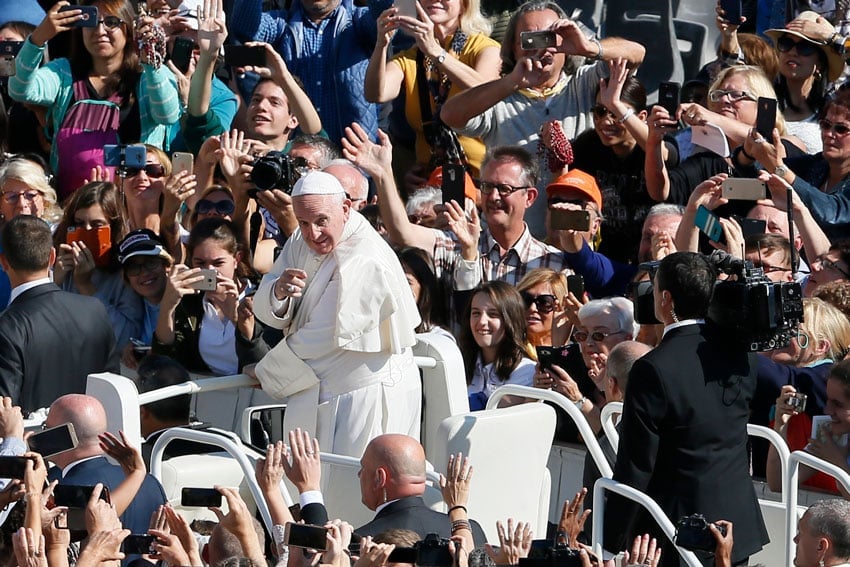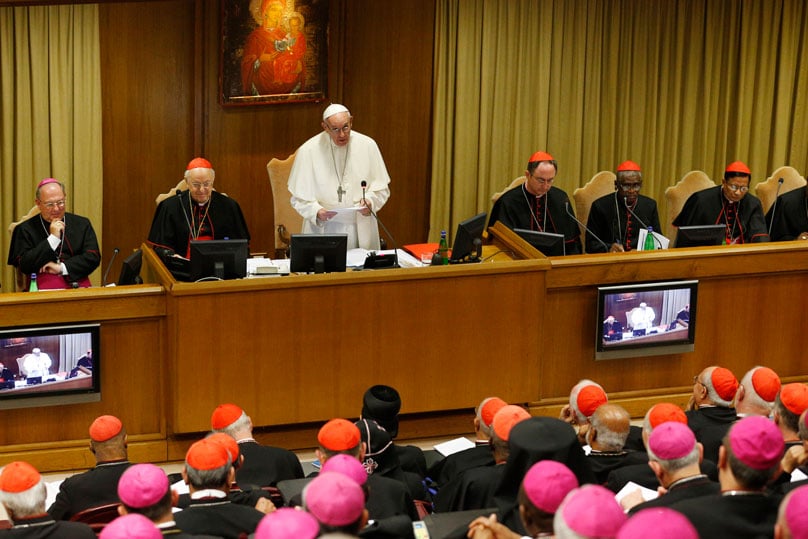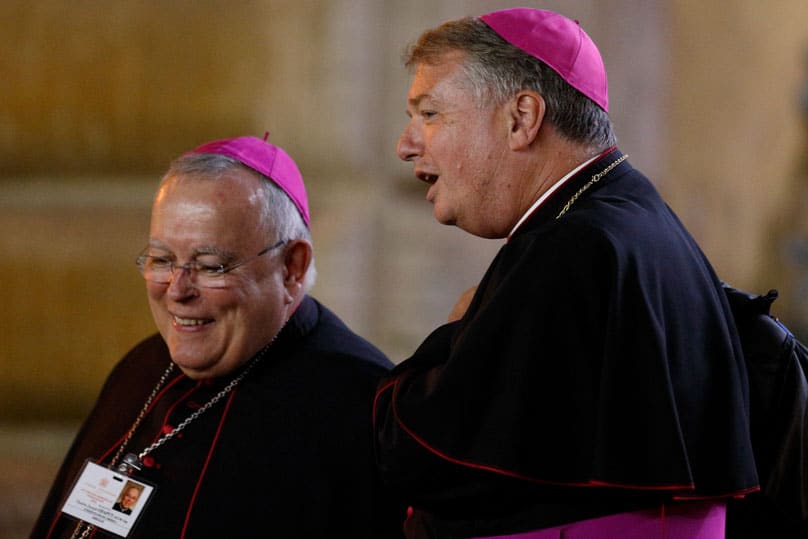
Reports and Commentary, from Rome and Elsewhere, on the XV Ordinary General Assembly of the Synod of Bishops: Young People, the Faith and Vocational Discernment. Edited by The Catholic Weekly’s Rome correspondent Xavier Rynne II.
COMMENTARY
On Improving the Synod’s Instrumentum Laboris: Part Two
In yesterday’s Letter, your editor offered several suggestions for improving Synod-2018’s working document, which will play an important role in shaping the Synod’s final report. Thus it was suggested that the Synod should consider the impact of the 21st-century breakdown of marriage culture on the evangelisation of young adults, with an eye to re-affirming the sacramentality of marriage and the Catholic ethic of love as self-gift; that the Synod lift up chastity – the integrity of love – as essential to human maturation, rather than indulging in secular nostrums about “discovering our sexuality;” and that the Synod recognise the failures of dumbed-down Catholicism while proposing the fullness of Catholic truth as the answer to the deepest longings of the human heart.
In addition, the Synod fathers and auditors might well address the unhappy fact that its working document, the Instrumentum Laboris, does not contain a single reference to “virtue.” This seems odd at a moment when, as one American theologian put it, contemporary culture is clamouring “for guides to virtuous living,” with “speakers and classes on secular virtue…proliferating” on campuses. This suggests a great opportunity to engage the world in the dialogue for which Vatican II called; and dialogue has, of course, been one of the signature words of the present pontificate. More than mere conversation, however, a genuine dialogue about virtue and the virtues would emphasise, from the Catholic dialogue partner, that the moral life, as the Catholic Church understands it and as John Paul II taught in the encyclical Veritatis Splendor [The Spendour of Truth], is not primarily a laundry-list of thou-shalt-not proscriptions, but a summons to beatitude, happiness, and genuine human flourishing.
Pope Francis has frequently criticised “legalism,” which the secular world typically identifies with Catholic orthodoxy and its insistence that some things are always and everywhere off-the-board, because these “intrinsically evil” acts radically contradict the dignity of the human person. But there is also a “progressive” legalism, which also misconstrues morality as primarily a matter of rules; the difference is that progressive legalism wants to loosen the rules, to the point where they often disappear into a fog of personal subjectivity and willfulness. Might the Synod remind both the Church and the world that the Catholic understanding of the moral life does not begin with rules (strictly or laxly applied), but with beatitude, and the virtues that make for fulfilment, happiness, and integrity of life – and then proposes “the rules” as guard rails along the journey to beatitude and happiness?
Too much of the Synod’s working document remains trapped in a legalistic cast of mind, albeit a progressive sort of legalism. So Synod-2018 would make a real contribution if its final report re-centered Catholic reflection on the virtues and the Magna Carta of the moral life, the Beatitudes of Matthew 5.3-11. In doing so, the Synod would help the world identify some of its present moral confusions and invite it to discover a path beyond them: a path that many are seeking now, however clumsily.
The Synod final report should also try to move beyond the Instrumentum Laboris by acknowledging that what is too often construed as a Catholic weakness – the permanence and solidity of the Church’s teaching – is in fact a great strength, especially today. Twenty-first century young adults live in a world of continuing flux, instant communications, and very little rootedness. That can seem exhilarating, for a time. But eventually, it becomes exhausting, as the quest for novelty leads down ever more bizarre (and often destructive) pathways. The Polish sociologist Zygmunt Bauman coined the term “liquid modernity” to describe this situation of permanent personal and social flux – and a lot of today’s young adults (and, of course, not-so-young adults) are floundering in that liquidity, trying to tread water and sometimes sinking.
In this situation, the Church will not successfully evangelise by becoming another institutional expression of liquid modernity; Catholicism will attract precisely because of its stability. Paradigm shifts are far less attractive to today’s young adults, and far less conducive to real vocational discernment than a winsome presentation of the perennial truths of Catholic faith, centered on a personal encounter with Christ the Lord.

The Instrumentum Laboris is also strangely reticent about the importance of beautiful, prayerful liturgy for the mission of evangelisation among young adults. This, too, seems myopic. For amidst today’s post-modern social liquidity, belonging to a community that regularly celebrates the Lord’s presence in its midst is a compelling alternative to a world in which autonomous individuals are typically left alone with their (sometimes misconstrued) rights. Moreover, if beauty is indeed the road to rediscovering truth and goodness in a world that confuses “truth” with opinion and “goodness” with willfulness, then the beauty of the liturgy becomes an invitation, not only to belonging, fellowship, and solidarity but to the virtues.
As mentioned here before, the Synod’s working document seems oddly trapped in the mindset of the 1970s. The Synod fathers would do the Church a great service by ensuring that the Synod final report reflects the realities of the 21st century, takes seriously the real advances that have been made in young-adult ministry, and thereby identifies the creative, hopeful path into the future for which Pope Francis called in his opening remarks to the Synod on October 3.
TESTIMONIES FOR THE SYNOD
Letters from the Synod-2018 has invited Catholics with a variety of experiences in living the synodal theme, “Youth, the Faith, and Vocational Discernment,” to share those experiences with our global audience and with the Synod fathers and auditors. Today’s reflection was written by Katrina Gallic, a graduate of the University of Mary in Bismarck, North Dakota, who lives in Washington, D.C. and works for the March for Life Education and Defense Fund.
Standing on the stage on January 27, 2017, looking out at the seemingly endless crowd, the full weight of what was about to happen struck me. As I gazed over their heads at the Washington Monument, I realised I was seconds away from hearing my voice amplified to every person in the crowd. As the student speaker at the March for Life, I knew at that moment I was not only representing my university and my classmates. I was speaking for the millions who could have been our classmates, our teammates, and our friends, but whose lives were snatched from them. What I once thought was someone else’s battle, was in fact very much my own.
A few years before I spoke at the March for Life, Nancy Keenan, then-president of NARAL Pro-Choice America, witnessed March participants outside her Washington office. In a media interview soon afterwards she commented, “They are so young. There are so many of them, and they are so young.” She was right! As the March for Life has grown older, its participants have become younger and younger. On average, about 80% to 90% of the participants at the March for Life are college age or younger. No other annual human rights march can boast of these numbers, not even popular marches that receive far more press coverage and funding. After witnessing the enthusiasm of the young pro-life marchers, Keenan stepped down as President of NARAL.
What is it about the pro-life movement and the March for Life that brings young people together from every corner of the United States? As a recent college graduate, pro-life woman, devout lifelong Catholic, and March for Life veteran, I believe I have an answer.
First, I cannot overstate that my generation has grown up with an access to information that was hitherto unfathomable. My younger siblings and I cannot remember a time before the Internet. Every sonnet Shakespeare ever wrote, or the current weather in Moscow, all are available at the touch of a button. Seeing our unborn sibling’s sonogram pictures on the family refrigerator and listening to their hearts beat is not a novelty for us; it is simply a part of waiting to meet our new brother or sister. Every year since we can remember, our society has grown in scientific knowledge and technological power.
But no amount of discovery answers the simple yet profound question: What should we do with that knowledge and power?

Archbishop Chaput’s October 4 Intervention
The following intervention was delivered on October 4 to the general assembly of the Synod by Archbishop Charles J Chaput, OFM Cap. of Philadelphia, Pennsylvania, reflecting on paragraphs 51-63 of the Instrumentum Laboris:
Brothers: I was elected to the Synod’s permanent council three years ago. At the time, I was asked, along with other members, to suggest themes for this Synod. My counsel then was to focus on Psalm 8. We all know the text: “When I look at thy heavens, the work of thy fingers, the moon and the stars which thou hast established; what is man that thou art mindful of him, and the son of man that thou dost care for him?”
Who we are as creatures, what it means to be human, why we should imagine we have any special dignity at all – these are the chronic questions behind all our anxieties and conflicts. And the answer to all of them will not be found in ideologies or the social sciences, but only in the person of Jesus Christ, redeemer of man. Which of course means we need to understand, at the deepest level, why we need to be redeemed in the first place.
If we lack the confidence to preach Jesus Christ without hesitation or excuses to every generation, especially to the young, then the Church is just another purveyor of ethical pieties the world doesn’t need.
In this light, I read Chapter IV of the Instrumentum Laboris, paragraphs 51-63, with keen interest. The chapter does a good job of describing the anthropological and cultural challenges facing our young people. In fact, describing today’s problems, and noting the need to accompany young people as they face those problems, are strengths of the Instrumentum overall. But I believe paragraph 51 is misleading when it speaks of young people as the “watchmen and seismographs of every age.” This is false flattery, and it masks a loss of adult trust in the continuing beauty and power of the beliefs we have received.
In reality, young people are too often products of the age, shaped in part by the words, the love, the confidence, and the witness of their parents and teachers, but more profoundly today by a culture that is both deeply appealing and essentially atheist.
The elders of the faith community have the task of passing the truth of the Gospel from age to age, undamaged by compromise or deformation. Yet too often my generation of leaders, in our families and in the Church, has abdicated that responsibility out of a combination of ignorance, cowardice, and laziness in forming young people to carry the faith into the future. Shaping young lives is hard work in the face of a hostile culture. The clergy sexual abuse crisis is precisely a result of the self-indulgence and confusion introduced into the Church in my lifetime, even among those tasked with teaching and leading. And minors – our young people – have paid the price for it.
Finally, what the Church holds to be true about human sexuality is not a stumbling block. It is the only real path to joy and wholeness. There is no such thing as an ‘LGBTQ Catholic’ or a ‘transgender Catholic’ or a ‘heterosexual Catholic’, as if our sexual appetites defined who we are; as if these designations described discrete communities of differing but equal integrity within the real ecclesial community, the body of Jesus Christ. This has never been true in the life of the Church and is not true now. It follows that “LGBTQ” and similar language should not be used in Church documents, because using it suggests that these are real, autonomous groups, and the Church simply doesn’t categorise people that way.
Explaining why Catholic teaching about human sexuality is true, and why it’s ennobling and merciful, seems crucial to any discussion of anthropological issues. Yet it’s regrettably missing from this chapter and this document. I hope revisions by the Synod fathers can address that.
For all updates on the Synod on Youth click here.
